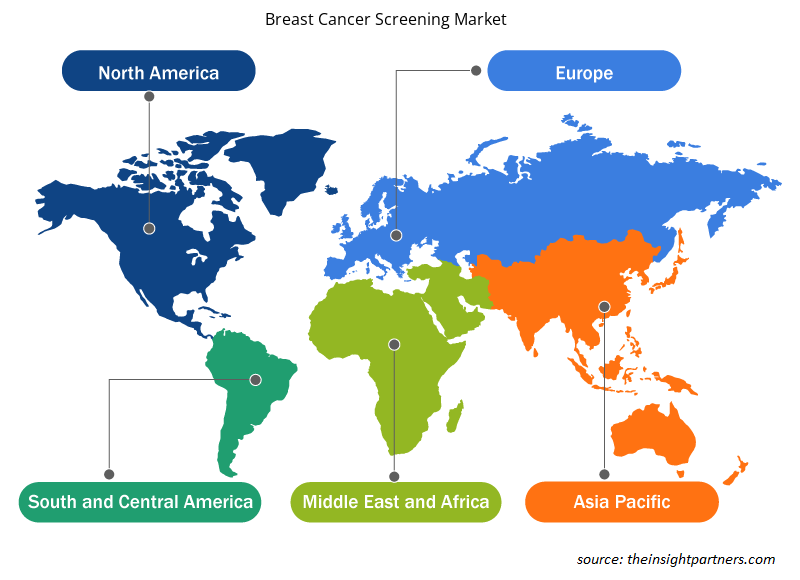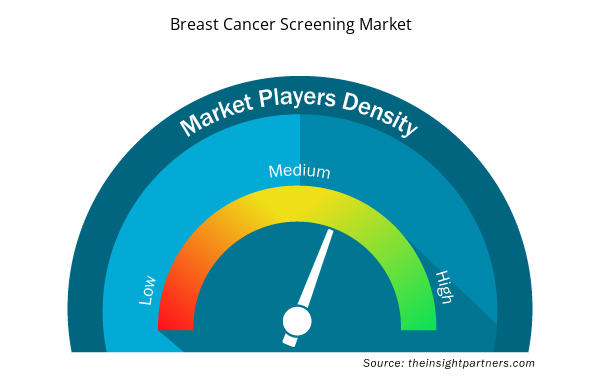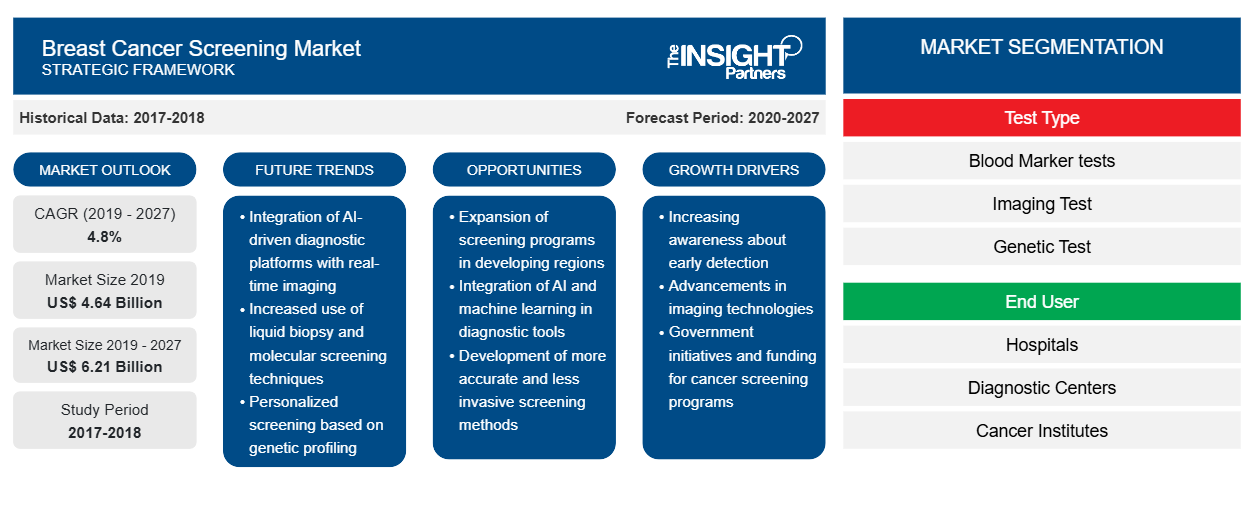[Informe de investigación] Se espera que el mercado de detección del cáncer de mama alcance los US$ 6.209,25 millones para 2027 desde los US$ 4.638,63 millones en 2019; se estima que crecerá a una CAGR del 4,8% entre 2020 y 2027.
El cáncer de mama es el tipo de cáncer más común y más extendido entre las mujeres; se desarrolla en los tejidos mamarios, generalmente en los conductos (tubos que llevan la leche al pezón) y los lobulillos (glándulas que producen leche). También puede aparecer en el tejido graso o el tejido conectivo fibroso dentro de las mamas. El diagnóstico temprano del cáncer de mama es importante, ya que puede evitar que la afección se vuelva crítica y garantizar un tratamiento curable exitoso. Los métodos de detección para el diagnóstico del cáncer de mama incluyen la mamografía, la resonancia magnética (MRI), la ecografía y otros. El objetivo principal de la detección es detectar la enfermedad en su etapa más temprana y más tratable. Los procedimientos de detección identifican los primeros signos de cáncer, incluso antes de que comiencen a manifestarse los síntomas.
Personalice este informe según sus necesidades
Obtendrá personalización en cualquier informe, sin cargo, incluidas partes de este informe o análisis a nivel de país, paquete de datos de Excel, así como también grandes ofertas y descuentos para empresas emergentes y universidades.
- Obtenga las principales tendencias clave del mercado de este informe.Esta muestra GRATUITA incluirá análisis de datos, desde tendencias del mercado hasta estimaciones y pronósticos.
Perspectivas del mercado
La prevalencia del cáncer de mama aumenta a nivel mundial
El cáncer de mama es una de las principales causas de muerte en el mundo y está afectando profundamente la calidad de vida. Por lo tanto, actúa como una carga para la sociedad si no se diagnostica y trata a tiempo. Según las estimaciones de la Sociedad Estadounidense del Cáncer, el cáncer de mama es el tipo de cáncer más común en los EE. UU., ya que causó morbilidad en ~234,087 personas y provocó 41,904 muertes en 2018. Además, se esperan ~276,480 casos nuevos en el país en 2020. Según el informe Globocan 2019, en Alemania, el número total de casos de cáncer de mama en 2018 fue de 71,888, y alrededor de la enfermedad provocó ~19,376 muertes en ese año. Además, según el informe Globocan, en 2018, hubo ~367,900 casos nuevos de cáncer de mama y 97,972 muertes debido al mismo en China. En la India, las ONG, las agencias gubernamentales y las organizaciones benéficas están haciendo hincapié en la concienciación sobre el cáncer de mama entre la población para promover la detección temprana, proporcionar un módulo de tratamiento integral y ampliar el apoyo para el manejo del cáncer de mama. Estas iniciativas son el resultado de la creciente prevalencia de este tipo de cáncer en el país. Según la estimación del informe Globocan, en 2018, la India informó de ~162.468 nuevos casos de cáncer de mama y 87.090 muertes debido a este. Esta creciente prevalencia del cáncer de mama en diferentes regiones del mundo está aumentando la demanda mundial de dispositivos de detección del mismo.Globocan 2019 report, in Germany, the total number of breast cancer cases in 2018 was 71,888, and around the disease lead to ~19,376 deaths in that year. Further, as per the Globocan report, in 2018, there were ~367,900 new cases of breast cancer and 97,972 deaths due to the same in China. In India, NGOs, government agencies, and charity organizations are emphasizing on breast cancer awareness among population to promote early detection, provide comprehensive treatment module, and extend support for breast cancer management. Such initiatives are a result of the increasing prevalence of this type of cancer in the country. As per the Globocan report estimation, in 2018, India reported ~162,468 new breast cancer cases and 87,090 deaths due to the same. Such growing prevalence of breast cancer in different regions around the world is raising the global demand for the screening devices for the same.
Perspectivas del mercado basadas en el tipo de prueba
El mercado de detección del cáncer de mama , por tipo de producto, está segmentado en pruebas de marcadores sanguíneos, pruebas de diagnóstico por imagen, pruebas genéticas y pruebas de inmunohistoquímica. El segmento de pruebas de diagnóstico por imagen tuvo la mayor participación del mercado en 2019 y también se prevé que registre la CAGR más alta del mercado durante el período de pronóstico.immunohistochemistry test. The imaging test segment held the largest share of the market in 2019, and it is also anticipated to register the highest CAGR in the market during the forecast period.
Información basada en el usuario final
En función del usuario final, el mercado de detección del cáncer de mama se ha segmentado en hospitales, centros de diagnóstico, institutos oncológicos y laboratorios de investigación. El segmento de hospitales tuvo la mayor participación del mercado en 2019, mientras que se estima que el segmento de centros de diagnóstico registrará la CAGR más alta del mercado durante el período de pronóstico.CAGR in the market during the forecast period.
El lanzamiento y la aprobación de productos es una estrategia que adoptan habitualmente las empresas del mercado de detección del cáncer de mama para expandir su presencia en todo el mundo y satisfacer la creciente demanda mediante la ampliación de sus carteras de productos. También adoptan la estrategia de expansión para ampliar la base de clientes en todo el mundo, lo que también les permite mantener su marca a nivel mundial. Por ejemplo, en junio de 2017, Siemens Healthineers recibió la aprobación de la Administración de Alimentos y Medicamentos (FDA) del producto syngo.via VB20, que probablemente se utilizará para imágenes moleculares (MI) de Siemens Healthineers, una nueva versión del software de visualización inteligente establecido de la empresa para imágenes multimodales.
Perspectivas regionales del mercado de detección del cáncer de mama
Los analistas de Insight Partners explicaron en detalle las tendencias y los factores regionales que influyen en el mercado de detección del cáncer de mama durante el período de pronóstico. Esta sección también analiza los segmentos y la geografía del mercado de detección del cáncer de mama en América del Norte, Europa, Asia Pacífico, Oriente Medio y África, y América del Sur y Central.

- Obtenga datos regionales específicos para el mercado de detección del cáncer de mama
Alcance del informe de mercado sobre detección del cáncer de mama
| Atributo del informe | Detalles |
|---|---|
| Tamaño del mercado en 2019 | US$ 4.64 mil millones |
| Tamaño del mercado en 2027 | 6.210 millones de dólares estadounidenses |
| CAGR global (2019-2027) | 4,8% |
| Datos históricos | 2017-2018 |
| Período de pronóstico | 2020-2027 |
| Segmentos cubiertos | Por tipo de prueba
|
| Regiones y países cubiertos | América del norte
|
| Líderes del mercado y perfiles de empresas clave |
|
Densidad de actores del mercado: comprensión de su impacto en la dinámica empresarial
El mercado de detección del cáncer de mama está creciendo rápidamente, impulsado por la creciente demanda de los usuarios finales debido a factores como la evolución de las preferencias de los consumidores, los avances tecnológicos y una mayor conciencia de los beneficios del producto. A medida que aumenta la demanda, las empresas amplían sus ofertas, innovan para satisfacer las necesidades de los consumidores y aprovechan las tendencias emergentes, lo que impulsa aún más el crecimiento del mercado.
La densidad de actores del mercado se refiere a la distribución de las empresas o firmas que operan dentro de un mercado o industria en particular. Indica cuántos competidores (actores del mercado) están presentes en un espacio de mercado determinado en relación con su tamaño o valor total de mercado.
Las principales empresas que operan en el mercado de detección del cáncer de mama son:
- Línea Koninklijke Philips NV.
- HOLOGICA, INC.
- BD
- GENÉTICA MIRIAD, INC.
- Siemens Health Care GmbH
Descargo de responsabilidad : Las empresas enumeradas anteriormente no están clasificadas en ningún orden particular.

- Obtenga una descripción general de los principales actores clave del mercado de detección del cáncer de mama
Mercado de detección del cáncer de mama: por tipo de producto
- Prueba de marcadores sanguíneos
- Prueba de imagen
- Prueba genética
- Prueba de inmunohistoquímica
Mercado de detección del cáncer de mama: por aplicación
- Centros de diagnóstico
- Hospitales
- Laboratorios de investigación
- Institutos del cáncer
Detección del cáncer de mama por geografía
- América del norte
- A NOSOTROS
- Canadá
- México
- Europa
- Francia
- Alemania
- Italia
- Reino Unido
- España
- Resto de Europa
- Asia Pacífico
- Porcelana
- India
- Corea del Sur
- Japón
- Australia
- Resto de Asia Pacífico
- Oriente Medio y África
- Sudáfrica
- Arabia Saudita
- Emiratos Árabes Unidos
- Resto de Oriente Medio y África
- Sudamerica
- Brasil
- Argentina
- Resto de Sudamérica
Perfiles de empresas
- Compañía General Electric
- Siemens Healthineers AG
- Corporación de Ciencias Exactas
- Philips NV, la línea Koninklijke
- Fabricante: Hologic, Inc.
- BD
- Genética Myriad, Inc.
- Corporación Oncocyte
- Danaher
- Sistemas médicos POC
- Análisis histórico (2 años), año base, pronóstico (7 años) con CAGR
- Análisis PEST y FODA
- Tamaño del mercado Valor/volumen: global, regional, nacional
- Industria y panorama competitivo
- Conjunto de datos de Excel


- Medical and Research Grade Collagen Market
- Trade Promotion Management Software Market
- Vision Care Market
- Aircraft Wire and Cable Market
- Excimer & Femtosecond Ophthalmic Lasers Market
- Artificial Intelligence in Defense Market
- Arterial Blood Gas Kits Market
- Lymphedema Treatment Market
- Virtual Pipeline Systems Market
- Military Rubber Tracks Market

Report Coverage
Revenue forecast, Company Analysis, Industry landscape, Growth factors, and Trends

Segment Covered
This text is related
to segments covered.

Regional Scope
North America, Europe, Asia Pacific, Middle East & Africa, South & Central America

Country Scope
This text is related
to country scope.
Preguntas frecuentes
The North American region holds the largest market for the breast cancer screening. The United States held the largest market for breast cancer screening mean market and is expected to grow due to factors such as increasing number of rising in prevalence of breast cancer, growing developments for screening and imaging process by the companies and others.
The diagnosis of breast cancer is done through breast cancer screening methods such as mammography, magnetic resonance imaging (MRI), ultrasound, and others. Screening examinations are tests performed for early diagnosis of the disease. The foremost goal of screening is to detect disease at its earliest and most treatable stage.
The growth of the market is attributed to some key driving factors such as increasing number of breast cancer cases, growing geriatric population and rising adoption of technology for screening purpose. However, high cost of screening method and bassinet on global business due to coronavirus pandemic are expected to restraint the growth of the market during the forecast years.
Trends and growth analysis reports related to Life Sciences : READ MORE..
The List of Companies - Breast Cancer Screening Market
- Koninklijke Philips N.V..
- HOLOGIC, INC.
- BD
- MYRIAD GENETICS, INC.
- SIEMENS HEALTHCARE GMBH
- Exact Sciences Corporation
- ONCOCYTE CORPORATION
- POC MEDICAL SYSTEMS
- Danaher
- GENERAL ELECTRIC
The Insight Partners performs research in 4 major stages: Data Collection & Secondary Research, Primary Research, Data Analysis and Data Triangulation & Final Review.
- Data Collection and Secondary Research:
As a market research and consulting firm operating from a decade, we have published and advised several client across the globe. First step for any study will start with an assessment of currently available data and insights from existing reports. Further, historical and current market information is collected from Investor Presentations, Annual Reports, SEC Filings, etc., and other information related to company’s performance and market positioning are gathered from Paid Databases (Factiva, Hoovers, and Reuters) and various other publications available in public domain.
Several associations trade associates, technical forums, institutes, societies and organization are accessed to gain technical as well as market related insights through their publications such as research papers, blogs and press releases related to the studies are referred to get cues about the market. Further, white papers, journals, magazines, and other news articles published in last 3 years are scrutinized and analyzed to understand the current market trends.
- Primary Research:
The primarily interview analysis comprise of data obtained from industry participants interview and answers to survey questions gathered by in-house primary team.
For primary research, interviews are conducted with industry experts/CEOs/Marketing Managers/VPs/Subject Matter Experts from both demand and supply side to get a 360-degree view of the market. The primary team conducts several interviews based on the complexity of the markets to understand the various market trends and dynamics which makes research more credible and precise.
A typical research interview fulfils the following functions:
- Provides first-hand information on the market size, market trends, growth trends, competitive landscape, and outlook
- Validates and strengthens in-house secondary research findings
- Develops the analysis team’s expertise and market understanding
Primary research involves email interactions and telephone interviews for each market, category, segment, and sub-segment across geographies. The participants who typically take part in such a process include, but are not limited to:
- Industry participants: VPs, business development managers, market intelligence managers and national sales managers
- Outside experts: Valuation experts, research analysts and key opinion leaders specializing in the electronics and semiconductor industry.
Below is the breakup of our primary respondents by company, designation, and region:

Once we receive the confirmation from primary research sources or primary respondents, we finalize the base year market estimation and forecast the data as per the macroeconomic and microeconomic factors assessed during data collection.
- Data Analysis:
Once data is validated through both secondary as well as primary respondents, we finalize the market estimations by hypothesis formulation and factor analysis at regional and country level.
- Macro-Economic Factor Analysis:
We analyse macroeconomic indicators such the gross domestic product (GDP), increase in the demand for goods and services across industries, technological advancement, regional economic growth, governmental policies, the influence of COVID-19, PEST analysis, and other aspects. This analysis aids in setting benchmarks for various nations/regions and approximating market splits. Additionally, the general trend of the aforementioned components aid in determining the market's development possibilities.
- Country Level Data:
Various factors that are especially aligned to the country are taken into account to determine the market size for a certain area and country, including the presence of vendors, such as headquarters and offices, the country's GDP, demand patterns, and industry growth. To comprehend the market dynamics for the nation, a number of growth variables, inhibitors, application areas, and current market trends are researched. The aforementioned elements aid in determining the country's overall market's growth potential.
- Company Profile:
The “Table of Contents” is formulated by listing and analyzing more than 25 - 30 companies operating in the market ecosystem across geographies. However, we profile only 10 companies as a standard practice in our syndicate reports. These 10 companies comprise leading, emerging, and regional players. Nonetheless, our analysis is not restricted to the 10 listed companies, we also analyze other companies present in the market to develop a holistic view and understand the prevailing trends. The “Company Profiles” section in the report covers key facts, business description, products & services, financial information, SWOT analysis, and key developments. The financial information presented is extracted from the annual reports and official documents of the publicly listed companies. Upon collecting the information for the sections of respective companies, we verify them via various primary sources and then compile the data in respective company profiles. The company level information helps us in deriving the base number as well as in forecasting the market size.
- Developing Base Number:
Aggregation of sales statistics (2020-2022) and macro-economic factor, and other secondary and primary research insights are utilized to arrive at base number and related market shares for 2022. The data gaps are identified in this step and relevant market data is analyzed, collected from paid primary interviews or databases. On finalizing the base year market size, forecasts are developed on the basis of macro-economic, industry and market growth factors and company level analysis.
- Data Triangulation and Final Review:
The market findings and base year market size calculations are validated from supply as well as demand side. Demand side validations are based on macro-economic factor analysis and benchmarks for respective regions and countries. In case of supply side validations, revenues of major companies are estimated (in case not available) based on industry benchmark, approximate number of employees, product portfolio, and primary interviews revenues are gathered. Further revenue from target product/service segment is assessed to avoid overshooting of market statistics. In case of heavy deviations between supply and demand side values, all thes steps are repeated to achieve synchronization.
We follow an iterative model, wherein we share our research findings with Subject Matter Experts (SME’s) and Key Opinion Leaders (KOLs) until consensus view of the market is not formulated – this model negates any drastic deviation in the opinions of experts. Only validated and universally acceptable research findings are quoted in our reports.
We have important check points that we use to validate our research findings – which we call – data triangulation, where we validate the information, we generate from secondary sources with primary interviews and then we re-validate with our internal data bases and Subject matter experts. This comprehensive model enables us to deliver high quality, reliable data in shortest possible time.


 Obtenga una muestra gratuita de este informe
Obtenga una muestra gratuita de este informe